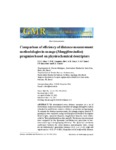Por favor, use este identificador para citar o enlazar este ítem:
http://www.alice.cnptia.embrapa.br/alice/handle/doc/919302Registro completo de metadatos
| Campo DC | Valor | Lengua/Idioma |
|---|---|---|
| dc.contributor.author | ALVES, E. O. S. | pt_BR |
| dc.contributor.author | SILVA, C. B. M. C. | pt_BR |
| dc.contributor.author | SOUZA, A. M. | pt_BR |
| dc.contributor.author | SANTOS, C. A. F. | pt_BR |
| dc.contributor.author | LIMA NETO, F. P. | pt_BR |
| dc.contributor.author | CORRÊA, R. X. | pt_BR |
| dc.date.accessioned | 2012-04-10T01:01:40Z | - |
| dc.date.available | 2012-04-10T01:01:40Z | - |
| dc.date.created | 2012-03-19 | pt_BR |
| dc.date.issued | 2012 | pt_BR |
| dc.identifier.citation | Genetics and Molecular Research, v. 11, n. 1, p. 591-596, 2012. | pt_BR |
| dc.identifier.uri | http://www.alice.cnptia.embrapa.br/alice/handle/doc/919302 | pt_BR |
| dc.description | We investigated seven distance measures in a set of observations of physicochemical variables of mango (Mangifera indica) submitted to multivariate analyses (distance, projection and grouping). To estimate the distance measurements, five mango progeny (total of 25 genotypes) were analyzed, using six fruit hysicochemical descriptors (fruit weight, equatorial diameter, longitudinal diameter, total soluble solids in °Brix, total titratable acidity, and pH). The distance measurements were compared by the Spearman correlation test, projection in two-dimensional space and grouping efficiency. The Spearman correlation coefficients between the seven distance measurements were, except for the Mahalanobis’ generalized distance (0.41 ? rs ? 0.63), high and significant (rs ? 0.91; P < 0.001). Regardless of the origin of the distance matrix, the unweighted pair group method with arithmetic mean grouping method proved to be the most adequate. The various distance measurements and grouping methods gave different values for distortion (-116.5 ? D ? 74.5), cophenetic correlation (0.26 ? rc ? 0.76) and stress (-1.9 ? S ? 58.9). Choice of distance measurement and analysis methods influence the characterization of genetic variability, and this should be taken into account for studies of mango. | pt_BR |
| dc.language.iso | eng | eng |
| dc.rights | openAccess | eng |
| dc.subject | Análise de agrupamento | pt_BR |
| dc.subject | Estatística multivariada | pt_BR |
| dc.subject | Divergência genética | pt_BR |
| dc.subject | Melhoramento genético | pt_BR |
| dc.subject | Multivariate statistics | pt_BR |
| dc.subject | Grouping analysis | pt_BR |
| dc.subject | Mango | pt_BR |
| dc.title | Comparison of efficiency of distance measurement methodologies in mango (Mangifera indica) progenies based on physicochemical descriptors. | pt_BR |
| dc.type | Artigo de periódico | pt_BR |
| dc.date.updated | 2018-01-26T11:11:11Z | pt_BR |
| dc.subject.thesagro | Manga | pt_BR |
| dc.subject.thesagro | Mangifera Indica | pt_BR |
| riaa.ainfo.id | 919302 | pt_BR |
| riaa.ainfo.lastupdate | 2018-01-26 -02:00:00 | pt_BR |
| dc.contributor.institution | E. O. S. ALVES, Universidade Estadual de Santa Cruz, Ilhéus, BA.; C. B. M. CERQUEIRA SILVA, Universidade Estadual do Sudoeste da Bahia, Itapetinga, BA.; A. M. SOUZA, Universidade Estadual do Sudoeste da Bahia, Itapetinga, BA.; CARLOS ANTONIO FERNANDES SANTOS, CPATSA; FRANCISCO PINHEIRO LIMA NETO, CPATSA; R. X. CORRÊA, Universidade Estadual de Santa Cruz, Ilhéus, BA. | pt_BR |
| Aparece en las colecciones: | Artigo em periódico indexado (CPATSA)  | |
Ficheros en este ítem:
| Fichero | Descripción | Tamaño | Formato | |
|---|---|---|---|---|
| CarlosAntonio2012.pdf | 411,24 kB | Adobe PDF |  Visualizar/Abrir |









